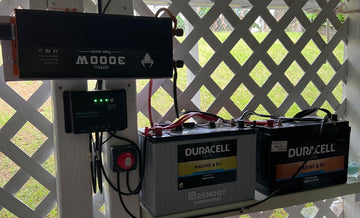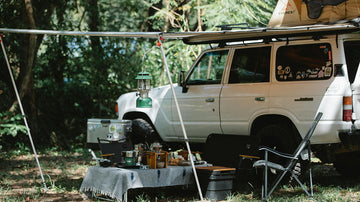Whether you're a crew member on a boat or a leisure boater, you can benefit from a boat solar system. Boats can keep their batteries fully charged without needing an external power source, even away from land. Boats can use solar energy to power appliances instead of other rechargeable sources, saving fuel costs and minimizing wear and tear on the engine. Start your journey to solar power for boats now.
Installing solar panels for boats is not difficult, so let's build a reliable and efficient solar system together!
How many solar panels does it take to power a boat?
Assessing power requirements
To properly design and select your system, you first need to determine whether your needs are to keep your batteries fully charged or to rely entirely on the solar system for power while you travel. While cost, mounting options, and performance are important, a successful installation depends on understanding what you want your system to do.
Could you make a list of appliances and equipment that are powered by solar panels? Examples include your fridge, coffee machine, LED lights, and how many movies you watch on your laptop at night. Calculate the wattage used by each electrical appliance and the number of hours you expect it to be used, then combine the data to convert it into the number of ampere-hours you need per day. Considering variables such as inverter losses and battery inefficiency, it's best not to underestimate your power consumption.
Once you have determined your electricity requirements, you need to calculate the amount of power you can get from the panels.
For example, a 100W panel can theoretically provide 500 watt-hours of electricity in 5 hours of direct sunlight. However, the actual output of a solar panel in the real world is affected by several factors including weather, season, latitude, temperature, shading, and the efficiency of the panel.
These inefficiencies are known as derating, and the derating factor is typically 0.8.
Mounting location
The size of the installation space also limits the size of the solar panels.
Consider the space available on the boat for the panels and ensure that they receive maximum sunlight without interfering with the operation of the boat or the activities of passengers and crew. Be aware of obstructions from antennas, masts, or other equipment that may affect the performance of the solar panels.
Typically, you would choose available space on the deck or roof of the boat. These areas usually receive direct sunlight and are unobstructed. You should also ensure that there is adequate airflow around the solar panels to prevent inefficiency caused by overheating.

What is the best type of solar panel for a boat?
To ensure optimum performance and longevity of boat solar systems, it is critical to select solar panels that are suitable for the marine environment. The marine environment is harsh and solar panels must be waterproof, corrosion-resistant, and durable to withstand challenges such as saltwater erosion, severe storms, and high humidity.
The weight of the ship is also an important consideration. Choosing lighter solar panels reduces the load on the ship's structure and helps improve the ship's performance and efficiency.
Structurally, there are three main types of solar panels: monocrystalline, polycrystalline, and amorphous (or thin film) technologies.
Monocrystalline solar panels have been around the longest and are still the most popular. These panels are made from thin crystalline silicon wafers encapsulated in a sturdy aluminum frame and covered with toughened shatterproof glass. Monocrystalline panels have a uniform black, blue, or grey appearance and are usually very strong. This type of solar panel performs well in different light conditions and is adaptable enough to work in a variety of environments.
Monocrystalline solar panels have the longest lifespan of the three types. With a conversion efficiency of around 17%, monocrystalline panels are the most efficient and have the highest power output per unit area, but they are also the most expensive.

Polycrystalline solar panels are made from cast blocks of silicon that are sliced to look like broken glass. Their construction and lifetime are similar to monocrystalline panels. Although polycrystalline solar panels have lower conversion efficiencies (as low as 14%), their relatively low manufacturing costs make them highly economical and competitive in the solar market.

Amorphous silicon solar panels are made by applying a thin film of activated silicon to a rigid or flexible substrate, such as stainless steel or aluminum, depending on whether the solar panel is made with a rigid frame and glass panel or a flexible panel. Flexible panels, where the cells are sandwiched between rubber and polymer covers, are light and strong enough to walk on and, in some cases, roll up for storage.

This type of solar panel is also a better choice where shading is an issue. Amorphous silicon panels can absorb a wider spectrum of light, allowing them to perform better in low-light conditions. With crystalline panels, even a thin shadow from a string or shroud covering a cell can reduce or stop the output of the entire module. Amorphous panels have 'bypass' diodes that essentially turn off the shaded cells and provide a current path around them. Some monocrystalline panels also have bypass diodes, but this feature adds cost.
Amorphous silicon solar panels have a relatively simple production process, low manufacturing costs, and are the cheapest of the three. But they are also less efficient - at around 8 percent, they are about half as efficient as monocrystalline silicon solar panels. However, this lower performance is mitigated by a new type of solar panel that uses a three-layer structure. Each layer absorbs a different color of the sun's spectrum, so this type of solar panel delivers more power per day for longer periods and in lower light conditions than the other two types.
Best marine solar panel kit

Most solar panels are designed for 15 to 20 V to overcome problems such as cloudy days or inherent resistance within the solar panel or mounting assembly. While this higher voltage can make up for days of lower electrical productivity, it also means that you will need to install a solar charge controller to avoid damaging your batteries by overcharging them.
This kit includes solar panels, solar charge controller, MC4 solar cable, 12AWG battery cable, solar panel mounting bracket, and a set of Y-branch adapter cables. It has a life expectancy of 20 years or more.
Marine solar panel installation
Once you've decided which solar panels to install, it's time to decide how to mount them on your boat. Solar panels should be mounted in a position that maximizes sunlight exposure but does not interfere with the operation of the vessel or the activities of passengers and crew. Solar panels are usually either fixed or mounted on some form of removable bracket, allowing the panels to be actively directed toward the sun for maximum output. Both methods have advantages and disadvantages. Fixed panels (usually mounted horizontally) don't produce as much power as panels that can be adjusted to face the sun. The disadvantage is that adjustable panels need to be facing the sun all day to maximize their output.
Fixing Methods
📍Glue Adhesives:
Using glue to fix brackets/mounts to the boat is a common method. Before starting, clean the surface area to remove any dust, grease, or contaminants which will help the adhesion of the glue. Some manufacturers recommend lightly sanding the surface to improve adhesion properties.
When choosing a glue make sure it is suitable for both the solar panels and the hull material.
📍Screws:
The mounting solution you choose will depend on your boat and where it will be used. Gluing solar mounts to a sailing yacht may not be the best idea, especially if you're in the middle of the Atlantic in force 9 winds. You will need to screw the mount to your roof. Just make sure you have sealant to fill the gaps after drilling the holes.
Top-of-pole marine solar panel mounting
Pole top mounted panels take up no space on the hull, keep the boat tidy, and are usually protected from shadows. Mast mounts can also be used as outboard motor lifts and electronic equipment mounts. The pole mount system allows the panels to rotate 360 degrees and lock into place to follow the sun throughout the day.
![]()
Boat roof mounting
The top of a boat is usually a large, open area suitable for installing solar panels to maximize the use of available space for solar energy collection. Roof mounting allows the solar panels to be placed in a more discreet location without taking up deck space, while also helping to keep the exterior of the boat clean.

Deck Mounting
Suitable for boats with a cockpit or hardtop, providing a robust and simple mounting option. Even infrequently accessed deck areas can be used to install solar panels, maximizing the use of available hull space. Where the deck is curved, semi-flexible panels allow a low profile, aesthetically pleasing installation. As with awnings, the panels cannot be adjusted to the optimum angle of the sun throughout the day and are susceptible to severe shading problems.

Side mounting
Sometimes mounting solar panels on the side of the boat is an option due to limited space on the top of the boat. This arrangement is usually hinged at the top, allowing the panels to be folded down to avoid obstruction when docking and to improve access to the boat. The hinged design of the panels is usually semi-adjustable, allowing some adjustment to changing light conditions. However, this type of installation tends to create more shade than a post and arch installation. More shade means fewer hours of average sunlight per day.

Video guide
Boat solar charge controller
The charge controller should be mounted under the deck as close to the batteries as possible. You must always follow the manufacturer's connection instructions, but in a typical installation, you would connect the positive (red) wire from the solar panel to the positive input wire or terminal of the charge controller and the negative (black) wire to the negative input wire or terminal of the charge controller.
Next, connect the negative output of the charge controller to the negative battery terminal via an appropriately sized series fuse (or circuit breaker) and the positive output of the controller to the positive battery terminal.
Finally, ensure that all connections are watertight and secure any loose wires with cable ties and cable clips to ensure a neat installation.

















